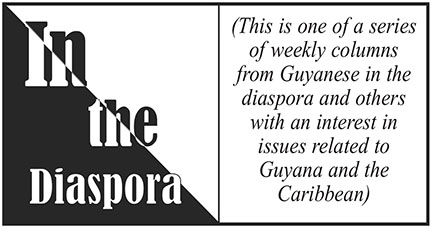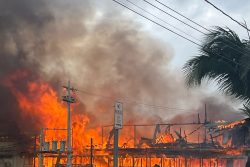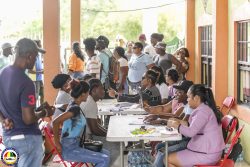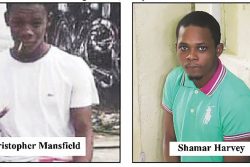By Rhoda Reddock
Rhoda Reddock is emerita Professor of Gender, Social Change, and Development at the University of the West Indies, St. Augustine campus. She also served as deputy Principal and first head of the Institute for Gender and Development Studies. Active in the national and Caribbean Women’s Movement and other social causes. Prof. Reddock is currently an executive member of the International Sociological Association (2018-2022) and an elected expert of the UN Committee for the Elimination of Discrimination against Women (2019 -2023).
This week’s column (Part One was published last week) was first presented at A Time for Healing: Understanding and Reconciling Race Relations in Trinidad and Tobago, a joint national symposium organised by The Faculty of Law, The University of the West Indies, St. Augustine Campus and the Catholic Commission for Social Justice (CCSJ), 30 August, 2020. Responding to the racial tensions during and after the 2020 Trinidad and Tobago elections, the symposium was described as an attempt to facilitate a “national conversation, focusing on understanding and healing…in an empathetic, balanced and objective environment. “
Last week’s column pointed to the dangerous myths and stereotypes about race in Trinidad and Tobago – dangerous because they have real consequences for society and for our everyday lives and relations across difference – and suggested that these myths generate little real understanding of the legacy of historical socio-economic and cultural forces at work. As I noted, racialized experiences in Trinidad and Tobago are shaped by a number of intersecting frames: Colourism and anti-Blackness; competing victimhoods; ethnic dualism; hybridity and mixedness. Let us look at the first two.
1. Anti-Blackness/Colourism
In 1970, like many of my generation I was influenced by the Black Power Movement. At my prestigious Anglican Girls High School, White girls began to acknowledge their African ancestors, Black girls were forced to confront the internalised racism that existed within themselves and to become proud of their colour and hair finally. I do know that the leaders of the movement spoke of the Unity of all “Black” people with the slogan “Africans and Indians Unite.” I also recall in 1990 when an Indo-Trini colleague said to me – Rhoda, I think there should be a 20 year commemoration of the 1970 Black Power revolution. “Why do you think so,” I asked. “Because,” he said, “that was an important turning point in my life. After that I was able to take my Indian food to school without feeling ashamed. It made us appreciate who we are”. Yet I am also aware of colleagues who sought to distance the Black power movement from Indians, reducing its national significance for the entire society.
The racist and colour systems of the colonial plantation era established a hierarchy of colour and phenotype and hegemony of “whiteness.” All groups were evaluated in terms of their closeness to Europeans in colour, phenotype and culture. It took a revolution to make Afro-Trinidadians challenge the internalised racism of our own anti-Blackness and to de-negativise notions of blackness, African practices, belief systems, and even the continent of Africa. Despite this, colour and phenotype continue to be visible markers of difference, and of class and ethnic stigmatisation. For Tobagonians, their dark skin colour was an additional factor contributing to the tensions with Trinidad.
Colleague and friend, Indian human rights activist and feminist, Kalpana Kannabiran would remind me during her visit to Trinidad in 1995, the year which marked 150 years of Indian arrival in Trinidad and Tobago, that colonial negativisation of blackness would have reinforced already existing negative notions of blackness brought to the region from South Asia. She would remind me that colour has also been an important signifier of status and difference in Indian society which no doubt, influenced Indian immigrants’ relationships with African descendants in the region and antipathy towards ‘blackness.’
This would have been compounded by the fear by Indo-Trinidadians of being invisibilised or losing their distinctiveness within an Afro-dominated Caribbean (i.e. ‘Black’) space. Although numerically well-represented in Guyana, Suriname and Trinidad and Tobago, Indians are deeply concerned about biological and cultural assimilation and disappearance into the Afro-Caribbean (i.e. Black) majority of the region.
Today, as Caribbean people, we continue to have this ambivalent relationship with ‘whiteness’ – a continued mistrust of ‘white people’ alongside an internalised acceptance of the superiority of ‘whiteness’; hence the sayings – ‘he feel he white’ or ‘she playing white’
suggesting that those persons are behaving above their status and/or colour, statements which actually reinforce the privilege of ‘whiteness.’
2. Competing Victimhoods
In the colonial period it was clearer who the oppressor was and who was the victim. Today, however, things are not so clear. How often have we heard the debates? Which groups have suffered more? Which groups were more oppress-ed during the colonial period, e.g. slavery or indentureship? Which groups are suffering more now? – Who has more jobs? More income? More land? More power? Who is more successful? Who is discriminating against whom? Who is being discriminated? Who has sacrificed more for the country? Who is the real victim here? Who is the oppressor and who is the oppressed now!
Narratives of suffering and sacrifice become important mechanisms for nationalist and ethnic mobilization. They serve to strengthen feelings of solidarity and community. They rally the troops to greater and greater struggle and sacrifice. They generate feelings of national or ethnic pride and stimulate masculinist notions of bravery in defence of women, family, community and nation. They also help to justify demands for compensatory justice and other strategies (legal or illegal) to improve the group’s access to social and economic resources.
These narratives are also able to create distance between self and others, which opens the way to violence and even genocide. In other words, such discourses focus so much on the other that there is no room for internal self–reflection or space to empathize with the situation of the other. We lash out from a space of pain and fear that does not allow us to feel the pain or fear of others. Racialized contexts are difficult enough when hierarchies are clearly visible; but where the groups concerned are relatively equally placed or equally displaced as in many parts of the postcolonial world, the potential for conflict is much higher.
First Nation peoples remind us that they are still around and have in fact not disappeared, despite what many historical texts might tell us. Through the committed efforts of contemporary descendants, Trinidad and Tobago society has been forced to address the absence of the indigenous inhabitants from the national history and the national census.
Afro-Trinidadians’ narrative of suffering begins with slavery and continues today, with their everyday experiences of discrimination. There is the perception of unequal access to economic resources and employment opportunities especially in the private sector and the continuation of colour and class discrimination by the state, banks, the private sector and civil society. More recently, there is concern at perceived inequalities in the education system especially affecting African children. They also point to the disproportionately large proportions of Afro-Trinidadian males in prison or killed by the (Afro-Trinidadian) police as well as continued discrimination in access to capital for investment in the private sector.
Afro-Tobagonians seek to reclaim Tobago’s separate and independent history of autonomy and self–governance that was lost when it was annexed and later made a ward of Trinidad in the late 19th Century. They highlight Tobago’s distinctive cultural and religious traditions and the continued subordination of its development to the vagaries of Trinidad.
For Indo-Trinidadians, their narrative begins with their exclusion from the imaginary of ‘the nation’. They note that despite their presence in this country and their economic and occupational success, they are still not perceived as full citizens. This is reflected in the fact that Indo-Trinidadian culture and religions are perceived as alien (and with the increase of certain strains of Christianity, once again as heathen) and therefore side-lined in the allocation of state resources. A Trinidadian identity, they argue, requires a rejection of their cultural and religious traditions. Importantly, they feel left out, ‘cheated’ of their right to shared political leadership of this country.
The minority of Europeans or Whites, today collectively referred to as French Creoles, note their increasing marginalisation in today’s society starting with the emergence of the Afro-Creole political hegemony characterised by Eric Williams’ famous statement in the immediate post-independence moment, “Massa Day Done”. Other groups e.g. Middle-Easterns and Chinese have their own narrative of exclusion. Their colour and presumed wealth create additional distance and mistrust, in a context shaped by racism and colourism.
Characteristic of all these groupings, is the underlying feeling of shame which we harbour about the ways we entered the societies – as oppressors, oppressed, as refugees, as illegal migrants or of diminished status. All of us carry this underlying shame that fuels our need to contest and seek to heal our wounded self-concept. This is where the myths, stereotypes, and adjusted histories come in, to create narratives of sacrifice even as we detail our narratives of suffering.
Meanwhile the former colonial masters who created this mess for their own economic benefit, accept no responsibility for the resulting civil wars, ethnic tensions and other forms of conflict which emerge in their former colonies. While criticising the instability in what they now describe as failed states and banana republics, they make billions selling arms to fuel these conflicts, ignoring the loss of life and social dislocation that often result.
The question is, where do we go from here? This is the moment to demand a politics that consciously and publicly attacks racism in all forms, establishing platforms that begin to forcefully challenge the very idea of ‘race’ that is embedded in our views of the world. Mec-hanisms must be introduced that don’t simply react but challenge us to imagine a different world. We can begin by rethinking what and how we teach our children, and the necessary reforms of our four-tiered education system and its over-competitive character. Our artists, writers and poets will be important here, and we must be prepared to listen. Some important measures include:
● The integration of anti-racist and diversity education at all levels of education, through public television and public radio, incorporating a deeper understanding of our history and sociology.
● Addressing the acerbity and violence of our language, and the absence of empathy and civility in how we address each other even as we debate, argue and contest. We are not all strong enough to take it.
● Relatedly, legislation on hate speech
The systemic factors reproducing and deepening social and economic inequalities must also be understood and frontally addressed through, for instance:
● In depth research and information sharing with the wider public.
● Revitalisation and strengthening of the social support systems including mental health, parenting support and inclusive education;
● Community social work interventions to facilitate early identification of vulnerable groups and multifaceted and gender-sensitive interventions;
● Strengthening of data collection systems to provide information for policy and planning;
As we observe ethnic tensions, conflict, violence and even genocide in other parts of the post-colonial world, let us not believe that “it can’t happen here” because it can.








